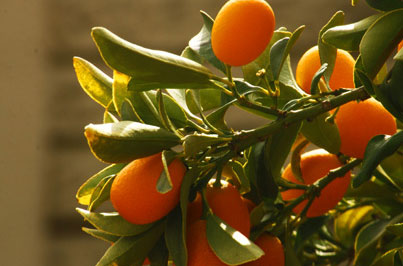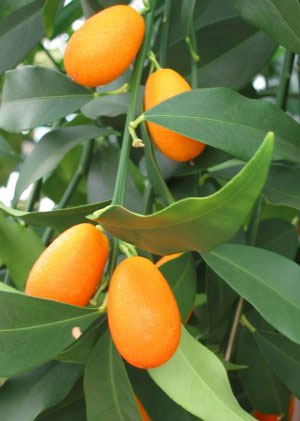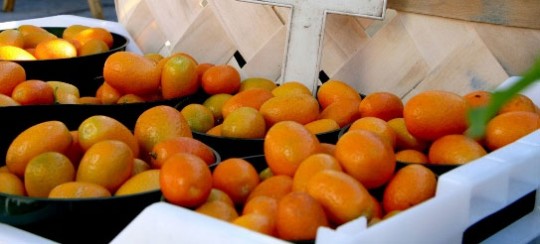Gardening: Kumquats Are The Gold Gem Of The Citrus Family
January 22, 2011
Extension Agents are sometimes the recipient of home grown fare. Each winter I look forward to the annual harvest of kumquats in my Master Gardener landscapes.
Kumquats (kuhm’ kwaht) have been called “the little gold gem of the citrus family”. The name kumquat comes from the Cantonese word for “golden orange”.
 Kumquats have a thin, sweet peel and a zesty, somewhat tart center. It’s the only fruit in the citrus family that you can eat “skin and all.” They are rich in potassium and low in calories. One kumquat is approximately 12 calories and yields 8.3mg calcium, 37mg potassium, 7.1mg vitamin C, and 57 IU vitamin A. They contain only a trace of fat, 3.1g carbohydrate and 15.5g water per fruit.
Kumquats have a thin, sweet peel and a zesty, somewhat tart center. It’s the only fruit in the citrus family that you can eat “skin and all.” They are rich in potassium and low in calories. One kumquat is approximately 12 calories and yields 8.3mg calcium, 37mg potassium, 7.1mg vitamin C, and 57 IU vitamin A. They contain only a trace of fat, 3.1g carbohydrate and 15.5g water per fruit.
They are believed to be native to China and were included in the genus Citrus until about 1915 when Dr. Walter T. Swingle set them apart in the genus Fortunella, in honor of the British horticulturist, Robert Fortune who introduced the kumquat to Europe in 1846.
Two varieties of kumquats are grown in Florida. The oval kumquat or Nagami (Fortunella margarita) is the most popular. The deep-orange fruit are small ovals, have 2-5 seeds, and are pleasantly flavored. The tartness of the fruit makes them great for use in cooking and for marmalades and jellies.
 The Meiwa (F. crassifolia) is sometimes called “the sweet kumquat” as this variety is not as tart as the Nagami. This round kumquat has a thicker peel, sweet pulp and juice, and is nearly seedless. While they are very good to eat, it is not recommended that you use them for cooking or for marmalade as they lack the tartness of the Nagami kumquats.
The Meiwa (F. crassifolia) is sometimes called “the sweet kumquat” as this variety is not as tart as the Nagami. This round kumquat has a thicker peel, sweet pulp and juice, and is nearly seedless. While they are very good to eat, it is not recommended that you use them for cooking or for marmalade as they lack the tartness of the Nagami kumquats.
This easy-to-grow evergreen tree reaches more than ten feet tall. It has few or no thorns and small, glossy leaves. The yellow-to-bright-reddish orange fruit are very showy and borne in large numbers. The fruit is considered ripe when it reaches a yellowish-orange stage, and has just shed the last tint of green. A steady harvest is available throughout the winter.
Kumquat trees grow well throughout Florida, planted in the landscape or in large containers. The trees are very cold hardy, and are highly resistant to citrus canker. The trees require about the same care as other citrus.
Whether grown in a container or in the ground, kumquats are heavy feeders and perform best with a regular fertilizing program. Be sure to water well before and after applying fertilizer to help prevent burn. If possible, buy a fertilizer formulated for citrus and one that has at least a third slow-release nitrogen. These slower-release fertilizers provide months of continuous nutrients, reducing effort and cost.
 Do not allow weeds or sod to grow up near the tree trunk. They will compete with root activity.
Do not allow weeds or sod to grow up near the tree trunk. They will compete with root activity.
Although pruning isn’t required, kumquats can be pruned to shape without diminishing next year’s fruiting ability. After harvest time, pick the fruit then prune the tree before new flowers appear. Remove suckers at the base of the trees anytime as they can sap the energy from fruit production.
Kumquats are an easy-to-grow plant that pays big harvest dividends in winter. After just a couple of years, they will begin bearing fruit and are a nice evergreen addition to the landscape. Try adding one or more to your landscape or garden.
Theresa Friday is the Residential Horticulture Extension Agent for Santa Rosa County.
Comments
11 Responses to “Gardening: Kumquats Are The Gold Gem Of The Citrus Family”




while looking up mayhaws I found they are part of the hawthorn family and can be grafted on. I have plenty, I mean plennnnnnnty of hawhorns in the field, would love to replace them with just about anything else. Mayhaws would be an interesting replacement. Leave the roots in place and graft on top of them, if I could just get the grafting to work……
Thanks for the tips, David.
only on how not to, based on my lack of success
Any tips on how to graft ■David Huie Green
green paint’s good
What I had read was that kumquats are the second most hardy citrus-like fruit. Only mock orange beats them but nobody eats them. I tried one time and am still spitting several years later. Nasty, waxy stuff.
Mock orange makes a good root stock for grafting onto. My kumquat is that way. Every year mock orange shoot comes up from below the graft and I have to cut it back.
Kumquat fruit supposed to survive down to about 28 but I had some make it to 27 without discernible damage. I figured they were already damaged and didn’t bother to wrap them to protect what I figured was already gone until it was too late–got colder than that. Even at that I ate a few Saturday and see a few behind the plastic. Don’t know how they survived, fairly dry so maybe they didn’t, still tasty.
The tree itself is supposed to be hardy down to around 20 F and we’ve seen that a few times already, at least I wrapped the bottom half and put in weak lights to warm it up above the 20 degree killer. (too cheap and lazy to get enough plastic to wrap over the top.
I gave a few to my mother-in-law a few times but she either let some freeze or put too much heat on them and cooked them. It happens. Now I just tend to bring her some fruit when available.
May try grafting myself some trees again and if successful, try again to give them to her. May not, got lots of plans of things which never get done.
David with a hundred years of plans
So David, your tree is OK and you only lost the fruit? I would love to grow a kumquat tree or two as I love those babies. I have tried to grow a couple of other types of citrus without any luck. I had some small (3′) or so saplings but they didn’t make the first winter.
I believe I had an orange and a tangerine if I remember correctly and my belief is that I didn’t have them mounded high enough so the cold got ‘em.I’m basically a city boy transplanted to Mc David and I am still leaning about growing things. My attitude in the past was to just paint my property green.
REGARDING:
“This easy-to-grow evergreen tree reaches more than ten feet tall. ”
and by more than ten feet tall, consider three kumquat trees across Longleaf Drive from West Florida and Pine Forest High schools. They look to be 40 feet tall or so, usually covered with fruit. Beautiful trees.
David the admiring and jealous
while my own is trimmed by the cold
I bought mine at Wal-Mart in Ensley several years back.
The fruit survived down to 27 degrees Fahrenheit this year, not so well below that. (And I didn’t wrap it up even though I knew better.) They say the tree can handle temperatures down to 20 F but now that I actually have the bottom half wrapped and a single string of incandescent Christmas tree lights providing gentle warming, I’m leaving them on since it keeps getting close to the kill temp.
Still got plenty of Chinese chestnut seedlings around the place, just set out a couple of crabapple seedlings from the Arbor Day giveaway yesterday.
David for fruits and nuts
Jeff’s on hwy 31 in Flomaton 251-296-0335 and Central Fam supply in Atmore 251-368-2787. Both sell excellent quality trees. Although it may be too late to get citrus trees. If so, they can tell you when the next crop will be availible.
Our feed stores at the northend and in Atmore have been selling them.
I have not seen any in the area stores for years and I love them. Who sells them locally?